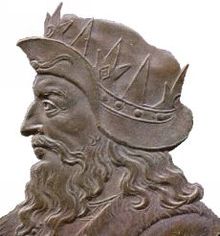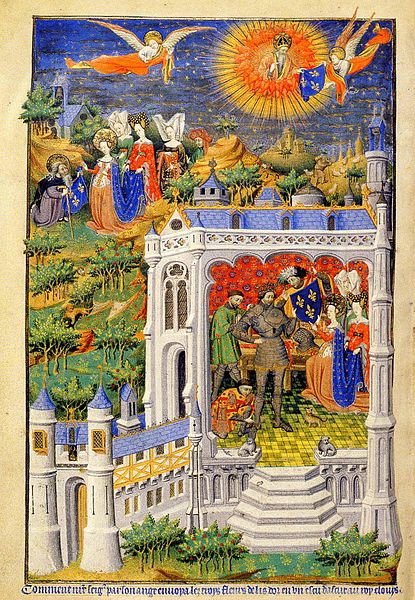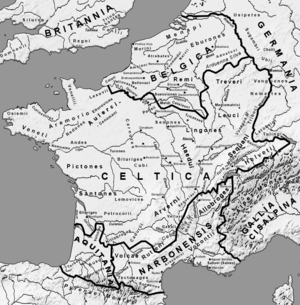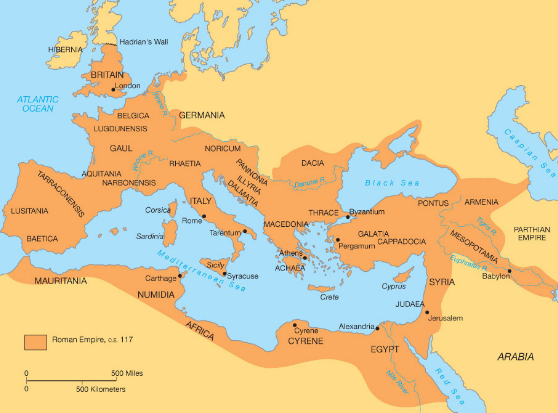Our story
This Chapter
Rough times
Enter Constantine "The Great"
Power of the elite
Eclasiastical power
Tribal power
Clovis I
Social status
Bibliography
Temper
Footnotes
|
|
May 8, 2001 Social history is history from the bottom up, a history of how people feel and react to ever changing circumstances. Those circumstances were radically different in the days of the first Merckelbach, Reynert Huyne von Merkelbeich, from what they are now; and more different still in the tenth century when Reynert's patrilinear ancestor Adalbert was born. We find him and his male descendants right up to Reynert in the rubric Roots. 3 We can descend the family tree further still if we consider Reynert's known female ancestors as well. Genealogist Ger de Vries made a, yet to be completed, ancestor table (here). In it we find Garibald I, Duke of Bavaria, born around 530; and Chlodio, born in 385 and who was king of the Salian Franks from 428 till 447; and Childebert, king of Cologne, born around 425; and Ruricius, Bisschop van Limoges, born in about the year 430, as well as his spouse, Hiberia of the Roman Empire. Also Flavius Petronius Maximus IV, Roman emperor from March 17, 455 until May 31 of that same year when the Vandals killed him at the behest of his very own wife because he had ordered the murder of her first husband, Emperor Valentinianus. Sweet revenge. 5 Knowing now that—to our taste!—things could get a little rough in those days, the following piece from a Greek-Latin primer for children, probably used early in the fourth century, may not be too surprising: 6 "The guilty thief is produced, is interrogated as he deserves; he is tortured, the torturer strikes, his breast is injured, he is hung up... he is beaten with sticks, he is flogged, he runs through the sequences of tortures, and he denies. He is to be punished; he is led to the sword. Then another is produced, innocent, who has a large patronage network with him; well-spoken men are present with him. This one has good fortune; he is absolved." 7 That ought to give some insight into the mindset inculcated in children of those who could afford to send their offspring to school. Judicial violence was deserved. Even witnesses were tortured unless they were well-connected members of the social elite .* We must avoid judging fifth or tenth century people by out 21st century wits. To understand our ancestors, we must adapt ourselves to their perception of the world, their way of judging one another, their way of living a life in their society with whatever moral standards then prevailed. Whether or not we are able to do so, that is another matter. It certainly will be tough. 8 John Paul II, pope from 16 October 1978 till his death on 2 April 2005, was not only the spiritual head of more than one billion believers, he also was a world statesman of immense stature and influence. And much loved. During his funeral ceremonies people shouted "Santo subito!" and, sure enough, soon an appropriate miracle was found to bring—according to strict rules—his sainthood about. Never mind that, personally, I am sceptical about such things, the reader may well ask who I am to judge. And didn't I just say that we should judge others by their wits, not ours?* 9 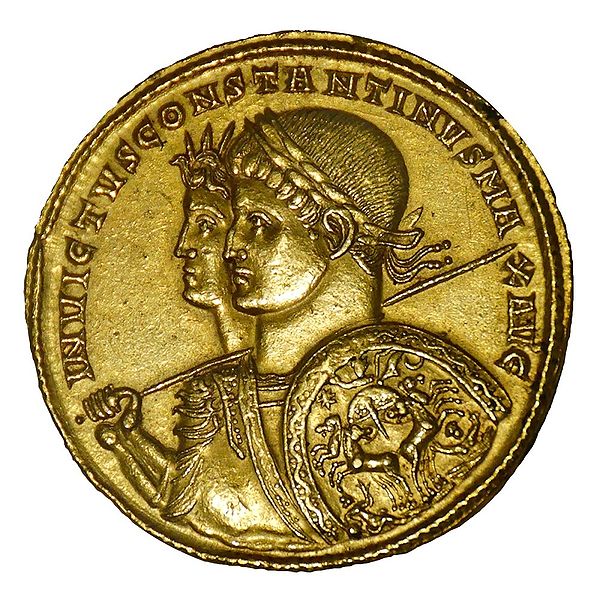 A gold coin showing Constantine with Sol Invictus. The use of Sol's image appea led to both the educated citizens of Gaul, who would recognize in it Apollo's patronage of Augustus and the arts; and to Christians, who found solar monotheism less objectionable than the traditional pagan pantheon. (Source) 10 The historical record shows that already early on Christian society (or societies) wielded religion, including the declaring of sainthoods, as a powerful tool to gain a strong foothold on the public mind and on the political scene. It is difficult to put out of one's mind that it was Emperor Constantine (reign: 306-373), a man who had his eldest son and wife murdered,* made Christianity the Roman state's official religion and that it was he who, in 325, convened the Council of Nicaea for hundreds of bishops near and far to settle matters of official doctrine. First item on the agenda was a dispute between Alexander, the Patriarch of Alexandria, and Arius, leader of a local congregation. Alexander held that Jesus was of the same substance as God; Arius posited that Jesus, although the most perfect of humans, was merely a creation of God the Father. The debate went on for about two months and became at one point so heated that Bishop Nicholas of Myra slapped Arius in the face. Yes, the very same gentle and kind St Nicolaas who, riding a white steed and accompanied by his happy helper, Zwarte Piet (Black Pete), is eagerly welcomed by European children each year on December 6 for the presents he brings to good boys and girls. In North America he is best known as Santa Claus. Alexander and Nicholas are now saints. Arius was declared a heretic and his writings were tossed in a fire. Ah, the twists and turns of people and their history! And, before we leave this paragraph: Constantine retained until his death the title of pontifex maximus, a title emperors bore as heads of Rome's pagan priesthood; and he is revered as Saint Constantine the Great in by the Eastern Orthodox and Coptic Orthodox churches. 11 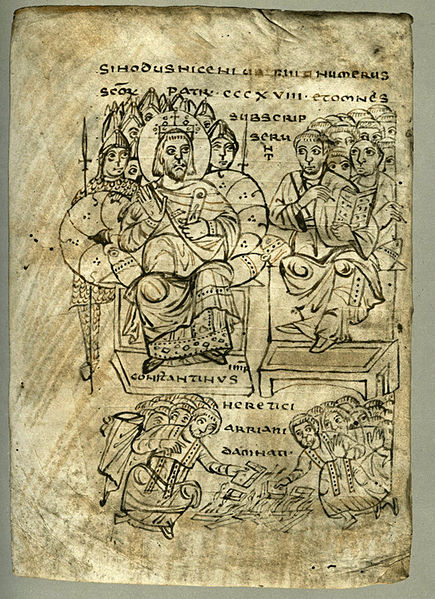 Saint Constantine the Great oversees the burning of Arius's heresies. The schism between Catholics and Arians was not Christianity's only dispute, its subsequent early history was riddled with ferocious philosophical quarrels about the nature of Christ in which bishops often inflamed entire flocks of the intellectually unwashed. Today's militant fundamentalism is hardly new. (Source) 12 Constantine did not use overt force to stamp out pagianism. Legislation would not suffice anyway and, besides, he badly needed capable administrators from a pool of mostly pagan subjects. They formed a newly created bureaucracy of which he was the head, but in so doing he made sure to favor prominent converts to Christianity with money and honors. Naturally, this resulted in many high-class conversions. He also gave the Church an increasingly powerful role in public affairs by appointing bishops to top administrative posts and by allowing that in a civil suit either litigant could, at any point in the proceedings, take his case to a local bishop for judgment, thereby putting a pagan litigant at disadvantage. He expropriated the properties ofpagan temples. He built many new churches and turned over to churches vast amounts of imperial property as endowments. Wealthy landowners began to follow suit and so the Church soon became the single most important landowner in Italy. Thus it was that Church, civil administration and politics became closely intertwined early in the history of Christianity. The Church became part and parcel of the legacy of the Roman empire. 13 The Roman empire may be viewed as a network of cities on which business, politics, patronage, and culture were focused. Influential people could hardly afford to stay away from the cities; and where the rich were, others were there too: their servants and entourages, merchants and artisans who wanted to sell them things, and the poor looking for charity. All of culture was bound up in civilitas, "cityness," whence our word civilization. Each city had a forum ringed with civic buildings and temples or, from the fourth century on, a cathedral and lesser churches. A city had a theater, an amphitheater,* and public baths. Cities had their own autonomous councils, until the fifth century that is, when the empire's centralizing authority began to levy increasingly heavy taxes mostly to pay for its armies. 14 Howevermuch we abhor the violence, injustice and corruption of Rome before the empire's collapse, bear in mind that what looks like corruption to us did not always seem so to the Romans themselves, at least not to their hardbitten elite. Those who belonged to the uppercrust, the patricians, understood one another perfectly well; they had their own justifications, upheld their own etiquette, and, most importantly, maintained social order and cohesion by means of a web of powerful influence and contacts. Underneath it all, there still was Roman law. It consisted of imperial legislation, which was very extensive in the fourth to sixth centuries, and a network of tracts by earlier Roman jurists, which represented a distillation of case-law precedents and the workings-out of legal principles. To master this properly required a special training, at the law-schools of Rome, Beirut or, after 425, Constantinople. 15 The Roman senatorial class and the provincial aristocracies shared a literary culture. They knew their Virgil and many other classical authors by heart, they wrote poetry and polished prose.* There was a pecking order based on this cultural capital. By the end of the fifth century, that cultural capital included the Bible, and for many the writings of Christian theologists such as Augustine. In Gaul, the office of bishop was becoming a standard part of a secular career progression for city notables, just as the pagan priesthood had been before; the traditional hierarchy of the Roman world had effectively absorbed the new power structures of Christianity although sometimes criteria other than wealth and birth permitted entry into the church hierarchy. Christianity was substantially absorbed into traditional Roman values, but never entirely. That literary culture was preserved by the Church, but not so in worldly affairs where the culture of post-Roman, i.e. Germanic, aristocracies were military. 16 As for Christianity, by 400, for the unlettered it was simply defined as the religion of the New Testament. If one believed (or said one believed) in the divine Trinity of the Father, Son and Holy Ghost, and if one believed that Jesus Christ, crucified in around AD 33, was the Son of God, and that no other gods existed, then one was Christian. These beliefs generally went together with an exaltation of poverty (for the good Christian ought to give everything to the poor) and a presumption that this world is only a brief testing ground before the eternal joys of heaven or the eternal tortures of hell, which meant that pleasure was risky, and that asceticism, sometimes self-mortification, was increasingly seen as virtuous. But it has never been the case that most Christians have taken the second of these sentences as seriously as the first. Christianization did not readily change people's minds about everyday morality and values. 17 To most pagans the air was full of powerful spiritual beings who were sometimes beneficent, sometimes not, sometimes controllable by magic, but above all fairly neutral to the human race. To many Christians this unseen world was divided among good angels and bad demons. Demons caused illness, bad-luck and ill-doing of all sorts; demonic possession was commonly seen as the cause of mental disturbance. Demons could be defeated, however, by clerical exorcism. 18 Pagan religion did not depend on an elaborate institutional structure, but Christianity had a complex structure partly matching that of the empire's secular administration. There were four patriarchs, the patriarch of Rome being called pope. Bishops were soon arrayed in two levels, with metropolitan bishops (called in later centuries archbishops) at an intermediate level, overseeing and consecrating the bishops of each secular province. Inside the dioceses of each bishop, which normally covered the secular territory of their city, bishops had authority over the clerics of other public churches (although privately founded churches and monasteries were often autonomous, a situation which produced endless disputes and rivalry for the next millennium). In the fourth and fifth centuries, the Church had perhaps a hundred thousand clerics of different types, more than the civil administration, and grew steadily increasing wealthy from pious gifts. Although not part of the state, its wealth and empire-wide institutional cohesion made it an inevitable partner for emperors and prefects, and a strong and influential informal authority in cities. The cathedral church by 500 was often the largest local landowner (and therefore patron), and, unlike in the case of private family wealth, its stability could be guaranteed for bishops were not allowed to alienate church property. It was ecclesiastical wealth and local status that led the episcopate to become part of elite career structures by the fifth century in Gaul. The fact that this institutional structure did not depend on the empire, and was above all separately funded, meant it could survive the political fragmentation of the fifth century, and the Church was indeed the Roman institution that continued with least change into the early Middle Ages. 19 Turning our attention to the Germanic tribes, the Roman historian Tacitus (56-117) described their character in his Germania. In short, they were warriors, but this terse bit of information is not sufficient for gaining an understanding of the life and times of the early Merckelbachs and their ancestors by other names. 20 Tacitus regards the whole of the numerous Germanic tribes as a single people with common traits and a common mode of life. A typical male is a warrior who leaves the management of his home and working the fields to his wife and his slaves. When not in battle, he loafs, drinks mead and gambles. Their leaders are military leaders; their assemblies are military gatherings. When a well-born male comes of age, he receives a shield and a spear and is likely to get his training among the companions of a distinguished chieftain. Here birth counts less than military skill and bravery with each companion striving for excellence. In battle, it is shameful for a chieftain to be surpassed in bravery by his companions, and a warrior is doomed to lifelong disgrace if he survives the leader. It is the sacred obligation of all companions to defend and support the leader and glorify him by valorous deeds. In return, they expect military equipment, food, and a share of whatever booty may be won. The bearing of arms was a mark of distinction. Becoming the follower of a chieftain was done with the expectation of maintenance befitting one's rank and not a mark of servility.* 21 Population pressures from the east made Germanic tribes move westwards. Among them were the Franks, a West Germanic tribal confederation first attested in the third century as living north and east of the Lower Rhine River. From the third to fifth centuries some Franks raided Roman territory while other Franks joined the Roman troops in Gaul and served to try stem the influx of additional tribes moving across the Rhine river into the empire. One group of Franks, the so-called Salian Franks, formed a kingdom on Roman-held soil that was acknowledged by the Romans after 357. They were a loose confederacy of tribes consisting of extended family groups centered around a particularly renowned or noble family. The importance of the family bond was made clear by the Salic Law, which ordained that an individual had no right to protection if not part of a family. 22 The Roman empire eventually collapsed because excessive taxation caused widespread poverty and discontent, conflicts within the military, the growing power of the Germanic subjects (who had learned a great deal about military arts from their service in Roman legions), and the Great Migration of peoples due to a push of Huns from the Asiatic steppes. In 475, the Germanic officer Odoakar, a Germanic king, took it on himself to rule a now rapidly decaying and fragmenting Roman empire where many a battle was fought between various Germanic tribes. 23 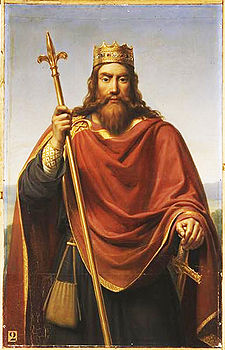 Clovis I as perceived by the painter François-Louis Dejuinne (1786-1844). Notice the fleur-de-lis; scuttlebutt had it that it came to Clovis from Heaven. A more earthy view is that the emblem has less in common with a lily than the iris still found along the river Luts or Lits in what is now the Netherlands. Before entering Gaul, the Franks had dwelled there for a long time. Three of that flower's six petals point alternatively straight up whereas the other three bend down. (Source 1, Source 2) 24 In the climate of the collapse of imperial authority in the West, it is Clovis I— also found among the Reynert Huyne von Merkelbeich's ancestors (Ref.)—who forcefully united the Frankish tribes. A pagan originally, he had himself and thousands of his followers baptized in the Catholic faith because he came to believe that the Christian God was more helpful in his military exploits than Wodan—according to Bishop Gregory of Tours. Baptisms of Clovis' followers and the tribes he conquered hardly led to instant Christians other than in name. For much of the populace religion was a matter of going through the motions while hanging on to their pagan beliefs. Insofar Clovis also subjugated Arian tribes he was looked upon with favor by the Pope. In his conquest of pretty well all of Gaul, Clovis rid himself of potential challengers by killing not only them, but also their male descendants. The Frankish political elite became an active force in spreading Catholicism through western Europe. Upon Clovis' death, in 511, his realm was split into the kingdoms of Rheims, Orléans, Paris and Soisson divided to be ruled by his sons Theuderic, Chlodomer, Childebert, and Clotarius who plotted, murdered and battled until only Chlotarius survived. The period of disunity and decay ensued that was to last for two and a half centuries. Roman roads, for example, were no longer maintained which led to a breakdown of the trading network among the empire's cities. These lost much of their population as the landholding elites moved to their country estates. Civitas dried up; society became rural. It is the Church that, through people like Gregory of Tours, carried the day after the ancient Roman empire had expired. 25 The Frankish kings moved their courts and administrators from palace to palace in the unruly northern part of Gaul, a practice by which they maintained their authority. But they ruled the richer and more Roman south through a network of dukes, counts, and bishops. Originally dukes were important military leaders of the ancient Roman army who could not be regular officers because they were not born in the empire. They were the kings' vassals enfeoffed with very extensive holdings. Counts ruled as representatives of the king. 27 Educated elites were brought up to be decorous and courteous. One was not supposed to lose one's temper, instead deploy one's rethorical skill to convince or humiliate an adversery, not use threats. But being angry with inferiors and threatening them, well that was another matter. The violence of late Roman political and judicial practice meant that such threats could be dangerous. Anger was a powerful weapon for kings and princes. 23 Roman tradition had it that married women were legally subject to their fathers although effectively subject to their husbands. They had inheritance rights over paternal and maternal property insofar money and moveable property were concerned, equally with their brothers and legally controlled their own property in marriage. As for land, this was usually not the case. Husbands were expected to front for their wives in public affairs such as court cases, but women had full legal rights to act on their own. Until the late fourth century, widows could not be legal guardians of their children, but in practice often did so. Women were not regarded as part of the public sphere and could not hold office; theirs was to run the household economy. But they were not prevented from being economic actors. A double standard for sexual behavior was sanctioned by law: men routinely had concubines, but brides were supposed to be virgins, and female adultery was indefensible. Women were regarded as weak and ignorant even though there is plenty of evidence for female literacy and literary engagement, particularly among the aristocracy. 24 Before ending this chapter, a brief note about the hoi-polloi. Whereas during the late Roman empire, the cultivated part of the countryside was dominated by large farms worked by slaves, somehow this evolved in small holdings worked by peasant families as tenants. At first those peasants were serfs who were obliged to remain with their land. 25 Bibliography
|
|
The paragraph was lifted from The inheritance of Rome, a scholarly work by Chris Wickham. Most of this chapter is based on Wickham's book with some paragraphs pretty well copied. The book is heartely recommended because it points to origins of many unquestioned assumptions about society to this very day. As for the rule of law, Francis Fukuyama in his The Origins of Political Order points out that, whereas societies seek to enforce basic social rules, a rule of law especially benefits a minority of privileged people. * fn1 For a view defended by those wihin, turn to this site. * fn2 Constantine had his eldest son Crispus put to death by poison, and had his wife, the Empress Fausta, killed at the behest of his mother, Helena. Fausta was left to die in an over-heated bath. Crispus' and Fausta's names were wiped from the face of many inscriptions, and references to their lives were erased from the literary record. More about (Constantine and Christianity..) * fn3 Under influence of the Church amphitheaters were later legislated against. * fn4 Virgil came to be regarded as one of Rome's greatest poets. His Aeneid, commisioned by Emperor August, can be considered a national epic of Rome. This epic poem consists of 12 books in hexameter verse which describe the journey of Aeneas, a prince fleeing to Italy from the sack of Troy and the foundation of a city from which Rome would emerge. In the Middle Ages, Virgil was considered a herald of Christianity because of some verses concerning the birth of a boy, which were read as a prophecy of Jesus' nativity. * fn5 Condensed from Carl Stephenson, Mediaeval Feudalism, p. 2. ff. Let me repeat, mine is not an attempt at original writing. Many a line is simply copied from other people's work (here from Carl Stephenson's The feudal age). The task which I set myself is to, as judiciously as I can within a short timeframe, to cobble together relevant pieces of information, not to write an original work. * fn6 Reminiscent of a remark made in more recent times, by Sir Winston Churchill: "History will be kind to me for I intend to write it." * fn7 |
--
| top of page |
|
Page maintenance:
Page format:monh xx, 2015
Story edit:
To be checked for timeliness:
¶ none
Reminders:
¶ none
Linkcheck: not done
XHTML verify: April 7, 2015
Backups: month. 25, 2011
Bibliography still to be added

